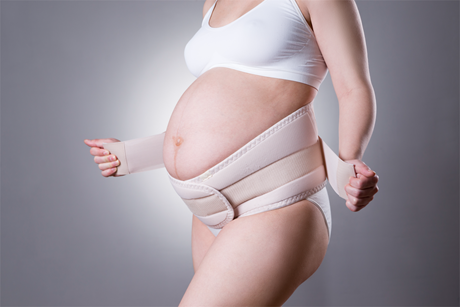Approximate Reading Time 2 Minutes
Low back pain? Pelvic girdle pain?
Finding it difficult to enjoy your pregnancy? Relief can be found in the form of:
- pregnancy belts or belly bands as they are commonly referred to
- specialised compression garments
- physiotherapy or some combination of these.
6 Reasons you need to be careful with a Pregnancy Belly Band and why it may not be the best solution for painful pelvic and back joints:

- Maternity support belt / pregnancy support belt may impair blood circulation, and negatively impact your pelvic floor and bowel function if worn too tightly or for too long.
- You are relying on your ‘feel’ to get the right level of compression, potentially risking muscle deactivation by having a potentially dangerous level of compression.
- Pregnancy support belts should only be worn for short periods, 2-3 hours to prevent dependency and deactivation of your muscles in your bottom, abdominals, and lower back, leaving you unsupported for most of the day.
- Most pregnancy belly belts/bands do not move with your body, can feel restrictive and need constant readjustment when sitting down or getting up.
- Pregnancy belts are not the most comfortable or flattering especially if you are wearing them under anything that is fitted.
- Many pregnancy belly bands / belly belts have hooks, loops, or Velcro so there is a chance of snagging your clothes.
SRC Pregnancy Leggings and Shorts are a specialised compression garment, recommended by women's healthcare professionals around the world.

Designed in consultation with an obstetrician for the ultimate in comfort and functionality, they utilise patented Anatomical Support Panels that deliver targeted compression, ideal for treating multiple conditions to help you enjoy your pregnancy and assist with:
- Low back pain
- Sciatic nerve pain
- Pelvic Girdle Pain (SIJ & SPD)
- Vulval and Varicose veins.
The multi-layered support panels called True Cross Compression, provide consistent and anatomically targeted compression during movement so compression is lost during movement. SRC pregnancy compression garments are an effective, evidence1 based choice for prevention and management of pain during pregnancy:
- 82% of women who wore SRC Pregnancy Shorts or Leggings experienced a reduction in their discomfort2.
- Backed by 100% Money Back Satisfaction Guarantee.
- Endorsed by Australian Physiotherapy Association & Australian College of Midwives.
They have all the benefits of belly bands and belly belts with none of the 6 disadvantages above.
Unlike belly bands, SRC Pregnancy Leggings and Shorts can treat various conditions, are more comfortable and convenient to wear and are therefore more likely to be worn for longer periods which increases their efficacy.

4 Reasons to wear Pregnancy Belly Bands / Belly Belts
Usually prescribed for extra postural support for severe symptoms of Pelvic Girdle Pain (PGP) and Pelvic Instability, there are good reasons to wear pregnancy belts / belly bands during your pregnancy, with the key here being SEVERE symptoms:
- Relieving pain in joints, muscles and lower back
- Assisting with the sacroiliac joint pain and hip joint pain
- Decrease the discomfort and provide support to the pelvic area during various activities by stabilising the pelvis and relieving pressure from the lower back.
- Help improve your posture
Some women combine both a pregnancy belly belt / belly band and the SRC Pregnancy Compression Shorts or Leggings. The benefit for women with severe pain is that they can wear their SRC Pregnancy Shorts/Leggings 24 hours per day without causing muscle atrophy due to prolonged muscle deactivation. During periods where they need to be on their feet for an extended time, they can combine both products by adding the pregnancy belly band over the top for additional support.













